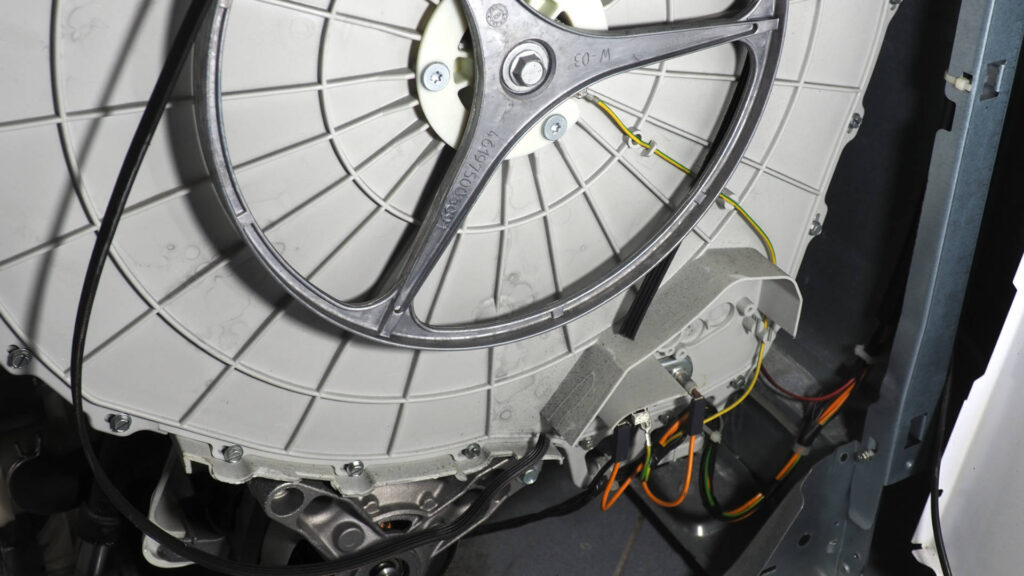If your washing machine isn’t doing its only job, it could be frustrating – to say the least!
Most of the time, a washing machine that does not spin properly is easily fixable.
But other times, the problem can be more complicated and you may require professional assistance.
Either way, it’s always better to start finding solutions on your own first.
That’s why in this guide, we will explore the common reasons behind a washing machine not spinning properly and provide practical solutions to get your appliance back in working order.
My washing machine won't spin, how can I fix it?
Here are a few common reasons a washing machine won’t spin.
- Your machine has an imbalanced load.
- Your machine has a faulty drive belt.
- There are lid switch problems with your machine.
- The motor component is faulty.
- The drain pump is faulty or clogged.
- The control board or main PCB are faulty.
1. Inbalanced Load
One of the most common reasons that may be causing your washing machine not to spin properly is a lack of even distribution of the clothing (during the wash cycles).
Due to the imbalanced load, the machine’s sensors may prevent it from spinning to avoid damage.
To resolve this issue, try the below tips.
- Open the machine and redistribute the clothes evenly inside the drum. Make sure to balance the weight of the items for a more even distribution.
- The surface where your machine is placed also plays an important role in how effectively your machine spins. Make sure that your washing machine is on a level surface. An uneven floor can contribute to load imbalance and affect the spinning cycle.
- Lastly, always stick to the drum capacity of your washing machine. For example, if the capacity is 6 kilograms, always stick to 6 kilograms to avoid damaging your product.
2. Faulty Drive Belt
In your machine, the drive belt is an important component that transmits the power from the motor to the drum of the machine.
With constant use and regular wear and tear, it may wear out or become damaged, leading to spin issues.
To address this problem, you need to open the back panel and inspect the belt.
If you notice any damage, the belt will need to be replaced.
On the other hand, if your drive belt has simply fallen off, you can try to re-attach it back on. However, if it continues to slip off the machine’s spider arm, it may require replacement.

3. Lid Switch Problems
Washing machines are also equipped with lid switches.
The lid switch on top-load washers is a safety device that stops the washer from agitating or spinning when the lid is raised.
If the switch is faulty or not engaging properly, it can lead to spinning issues.
To fix this issue, here’s what you can do…
- Inspect the lid switch for any visible damage or misalignment. If necessary, clean the switch and ensure it clicks into place when the lid is closed.
- If the lid switch is beyond repair, consider replacing it with a new one. Consult your washing machine’s manual for guidance on the replacement process.
If you have a front-loading washing machine, the same principles apply.
If your door cannot close and lock properly, the washing machine cycle will not progress, and therefore, your machine will not spin.
4. Faulty Motor Component
The motor inside of your appliance is an essential component of the machine that connects to the drum and allows the spinning cycle to operate.
And… just like other components, this motor can also wear out over time, especially in high-usage machines.
To troubleshoot, you will need to gain access to the component via the back panel. Once the motor is located, you need to inspect it for signs of damage. If possible, you can also test the motor using a multimeter.
If unsure, you can contact a washing machine professional like Georgi’s Services who will be happy to help.
5. Clogged or Faulty Drain Pump
If you have a clogged or malfunctioning drain pump it can impede the draining process, leading to spin problems.
If water is not expelled properly from the washing machine after every wash, the machine won’t be able to spin efficiently.
Here’s how to tackle this issue…
- Check for any debris, lint, or foreign objects obstructing the pump. Clean the pump thoroughly (if required).
- Run a test cycle to verify if the drain pump is working as expected. If it’s not, consider replacing the pump with a new one. You can also test it using a multimeter.
6. Control Board / PCB Problems
The control board and PCB of your machine are the components that govern the functions of the washing machine, including the spinning cycle.
If you have a problem with either your control board or PCB, it can lead to spinning issues.
Unfortunately, these components cannot be accurately tested using a multimeter, instead, you will have to visually inspect them for damage such as burnt marks.
If there is no visible damage to your control board and or PCB, diagnosing these components as faulty can be difficult.
If you’re having trouble, we recommend contacting a professional.
Conclusion
In this guide, we have explored several reasons that may be causing your washing machine to not spin properly.
But if you’re still not able to find a solution to your problem, it’s advisable to seek professional help.
And what better way than to seek help from Georgi’s Services?
You can contact us for a friendly and professional service.
We highly recommend checking out our prices too.

